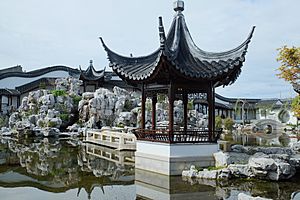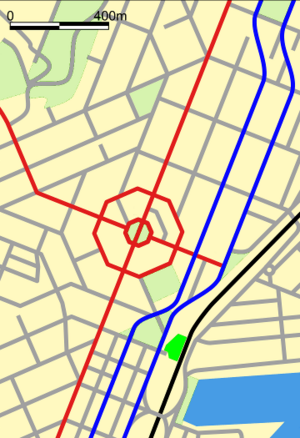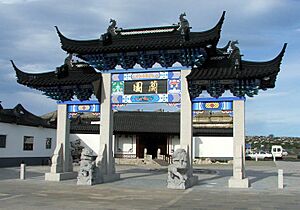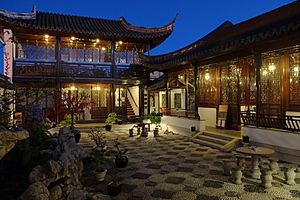Dunedin Chinese Garden facts for kids
Lan Yuan, the Dunedin Chinese Garden, is a special garden located in Dunedin, a city in southern New Zealand. It's right next to the Toitū Otago Settlers Museum and close to other cool places like the Dunedin Railway Station and Queens Gardens. This garden is a peaceful spot in the middle of the city, showing off beautiful traditional Chinese design.
Contents
What's in a Name? The Story of Lan Yuan
The garden is called Lan Yuan (蘭園). This name was chosen carefully because it has several meanings. The word lan (蘭) is the third part of New Zealand's Chinese name (niu xi lan, 紐西蘭). It's also part of the name for the Yulan magnolia flower, which is often linked to Dunedin's sister city, Shanghai. The word lan by itself means 'orchid'. The garden is also known as "The Garden of Enlightenment."
This garden celebrates the important contributions of Chinese people to Dunedin's history and culture. Many Cantonese people settled in and around Dunedin during the Central Otago Gold Rush in the 1860s. This was only about 15 years after the city was first founded. Today, over two percent of Dunedin's population has Chinese heritage.
How This Amazing Garden Was Built
The idea for a Chinese Garden in Dunedin first came up in 1997. This was during the planning for the city's 150th birthday celebrations. Since Chinese culture is a big part of Dunedin's history, everyone thought a garden would be a great idea. A special committee was formed, and a spot was chosen near the historic railway station and the Otago Settlers' Museum.
Some people worried the spot might be too windy, and a few were against building the garden. But despite these concerns, the project moved forward. Foundation stones were laid in March 1998 by people from the garden committee, the Dunedin City Council, and the deputy mayor of Shanghai.
Most of the money for the garden came from public donations. In 2006, the New Zealand Government also gave a lot of support, adding NZ$3.75 million.
The garden is a truly authentic Chinese Garden. It was built with help from the Dunedin City Council and the Shanghai Municipal Government. It cost $7 million to build. This garden is New Zealand's only authentic Chinese Garden. It's also one of only three outside China and the first of its kind in the Southern Hemisphere! The other two authentic Chinese Gardens outside China are in Portland, USA, and Vancouver, Canada.
The garden's design took eight years to plan. This made sure it was practical, accurate, and truly authentic. It's built in the traditional yuanlin (園林) style. It was designed by experts from Shanghai, who based it on the traditional gardens of the Jiangnan area. These gardens are considered the best examples of Chinese garden style. They are also perfect for smaller spaces in cities.
Experts from Shanghai carefully watched over the building and design. Most of the garden was first built in Shanghai on a site exactly like the one in Dunedin. Then, it was taken apart and rebuilt in New Zealand. Artisans from Shanghai helped with this process. The only things not brought from China were the water, the fish in the lake, the plants, and the concrete.
About 40 workers and artisans from Shanghai came to New Zealand to help build the garden. They were paid at least the New Zealand minimum wage. They worked long hours, typically seven days a week, with one day off each month. The construction involved pouring a lot of concrete and using over 280 tonnes of sand. They also used 130 tonnes of hand-finished granite paving stones. Plus, 380,000 hand-made roof tiles, bricks, and lattice-work were used.
Almost 1000 tonnes of rock from Lake Tai in China were brought in for the garden. These rocks have been important in Chinese architecture for over 1000 years. They arrived in over 40 shipping containers! Most of these special rocks form the climbing mountain in the garden. About a third were used to line the pond and create other rock features.
The garden was blessed in June 2008. The Prime Minister of New Zealand, Helen Clark, and the Chinese ambassador, Zhang Yuanyuan, were there. The garden opened to the public the next month. Prime Minister Clark returned to officially open the garden in September 2008.
Cool Features of the Garden
Lan Yuan, Dunedin Chinese Garden, is designed like a Scholar’s garden from the late Ming or early Qing periods. A 4-meter high wall separates it from the rest of the city. The garden is built around a large lake, with many buildings around it. These include an entrance hall, a square pavilion, a study, a climbing mountain with a half-pavilion, a tea house, and a two-story tower with a meeting room. A zig-zag bridge crosses the lake and leads to Chongyuan, the central "Heart of the Lake" pavilion.
At the garden's entrance, there's a beautiful Pai Lou archway, which is like the garden's "face." Two lion statues, carved from solid granite, stand on either side of the entrance. These were a gift from the Shanghai government. Just in front of the main door, a "river" marks the boundary between the outside world and the peaceful garden inside.
Traditional Chinese building methods were used throughout the garden. This means no nails or other materials that could rust were used. All the wooden structures, made from Chinese fir wood, are held together using special joints called mortise and tenon joints. The wood has seven layers of protective lacquer to keep it looking good and prevent it from rotting. All the wooden columns sit on hand-carved granite bases. This keeps the wood off the ground, which also helps prevent rot. Hand-carved hexagonal lanterns light up the paths at night. They have shades showing typical Chinese landscape paintings.
All the hand-made terracotta roof tiles came from Suzhou in China. They include special drip tiles that control how water runs off the roofs. This is a common practice in traditional Chinese garden design. The tiles are decorated with flower symbols, showing that it's a public garden.
The paths in the garden are paved with hand-made tiles in a herringbone pattern. The different courtyards have amazing pebble mosaics. These were laid by hand by the Chinese artisans. Over two tonnes of pebbles, also brought from China, were used in the garden.
Other traditional features include a curved bridge, a moon gate, and a double corridor. Potted plants and sculptures along the paths and in the courtyard add to the calm atmosphere. The buildings include a tea house, which would have been a dining room for scholars. There's also a study, which was a quiet place for thinking. The tower block and three pavilions are also important. These are the hexagonal Heart of the Lake pavilion, a half-pavilion on the climbing mountain, and a square pavilion.
The garden's design carefully balances moving and still elements, with still elements being more common. The best views are those overlooking the central lake. Winding paths connect the different parts of the garden.
Visiting the Garden
The garden covers an area of about 2500 square meters (27,000 square feet). Trees planted around the outside walls will eventually block out the city's sights and sounds. This will make the garden an even more peaceful oasis in the city center. As of 2013, over 30,000 people visit Lan Yuan, Dunedin Chinese Garden, every year.
The garden is open seven days a week. It has a gift shop selling unique items you won't find in regular souvenir shops. Visitors can also buy and enjoy Chinese teas, steamed buns, and dumplings at the Tea House. Lan Yuan, Dunedin Chinese Garden, is also a popular place for weddings, small business meetings, and other events.





